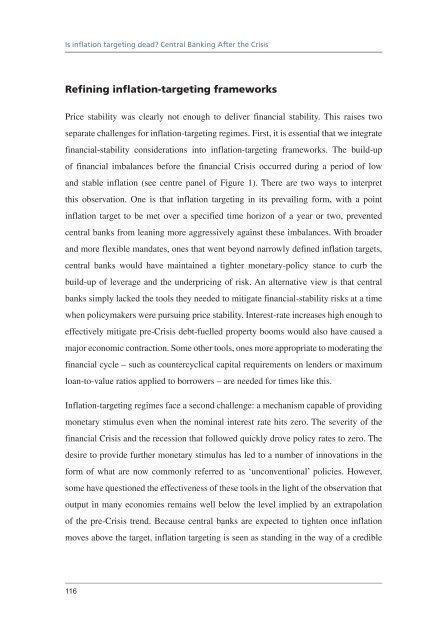Is inflation targeting dead? Central Banking After the Crisis - Vox
Is inflation targeting dead? Central Banking After the Crisis - Vox
Is inflation targeting dead? Central Banking After the Crisis - Vox
You also want an ePaper? Increase the reach of your titles
YUMPU automatically turns print PDFs into web optimized ePapers that Google loves.
<strong>Is</strong> <strong>inflation</strong> <strong>targeting</strong> <strong>dead</strong>? <strong>Central</strong> <strong>Banking</strong> <strong>After</strong> <strong>the</strong> <strong>Crisis</strong>Refining <strong>inflation</strong>-<strong>targeting</strong> frameworksPrice stability was clearly not enough to deliver financial stability. This raises twoseparate challenges for <strong>inflation</strong>-<strong>targeting</strong> regimes. First, it is essential that we integratefinancial-stability considerations into <strong>inflation</strong>-<strong>targeting</strong> frameworks. The build-upof financial imbalances before <strong>the</strong> financial <strong>Crisis</strong> occurred during a period of lowand stable <strong>inflation</strong> (see centre panel of Figure 1). There are two ways to interpretthis observation. One is that <strong>inflation</strong> <strong>targeting</strong> in its prevailing form, with a point<strong>inflation</strong> target to be met over a specified time horizon of a year or two, preventedcentral banks from leaning more aggressively against <strong>the</strong>se imbalances. With broaderand more flexible mandates, ones that went beyond narrowly defined <strong>inflation</strong> targets,central banks would have maintained a tighter monetary-policy stance to curb <strong>the</strong>build-up of leverage and <strong>the</strong> underpricing of risk. An alternative view is that centralbanks simply lacked <strong>the</strong> tools <strong>the</strong>y needed to mitigate financial-stability risks at a timewhen policymakers were pursuing price stability. Interest-rate increases high enough toeffectively mitigate pre-<strong>Crisis</strong> debt-fuelled property booms would also have caused amajor economic contraction. Some o<strong>the</strong>r tools, ones more appropriate to moderating <strong>the</strong>financial cycle – such as countercyclical capital requirements on lenders or maximumloan-to-value ratios applied to borrowers – are needed for times like this.Inflation-<strong>targeting</strong> regimes face a second challenge: a mechanism capable of providingmonetary stimulus even when <strong>the</strong> nominal interest rate hits zero. The severity of <strong>the</strong>financial <strong>Crisis</strong> and <strong>the</strong> recession that followed quickly drove policy rates to zero. Thedesire to provide fur<strong>the</strong>r monetary stimulus has led to a number of innovations in <strong>the</strong>form of what are now commonly referred to as ‘unconventional’ policies. However,some have questioned <strong>the</strong> effectiveness of <strong>the</strong>se tools in <strong>the</strong> light of <strong>the</strong> observation thatoutput in many economies remains well below <strong>the</strong> level implied by an extrapolationof <strong>the</strong> pre-<strong>Crisis</strong> trend. Because central banks are expected to tighten once <strong>inflation</strong>moves above <strong>the</strong> target, <strong>inflation</strong> <strong>targeting</strong> is seen as standing in <strong>the</strong> way of a credible116














